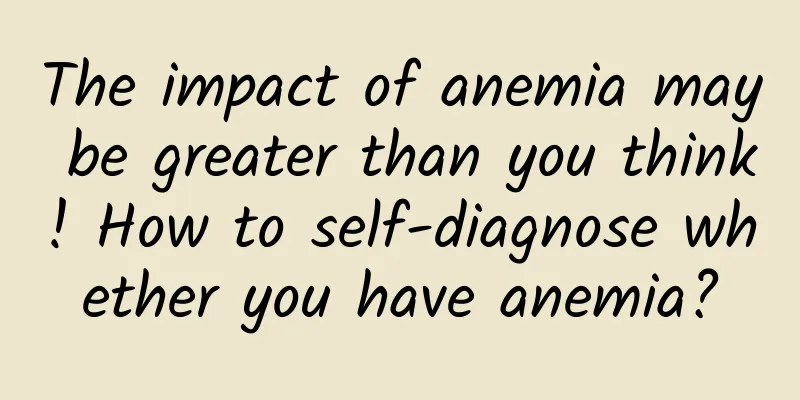The impact of anemia may be greater than you think! How to self-diagnose whether you have anemia?

|
Author: Han Bing, Chief Physician, Peking Union Medical College Hospital Reviewer: Duan Yanlong, Chief Physician, Beijing Children's Hospital, Capital Medical University Anemia, like fever, is a symptom that may be associated with a variety of diseases. Generally speaking, anemia is easy to diagnose. When the level of red blood cells, hematocrit, or hemoglobin in the body is below the lower limit of normal, it is defined as anemia. Figure 1 Original copyright image, no permission to reprint 1. What are the causes of anemia? The most common is nutritional anemia. Some are caused by insufficient nutritional intake, such as insufficient intake of meat, eggs, and various nutrients; some are caused by unbalanced nutrition, picky eating, and not eating certain foods, such as lean meat, eggs, seafood, and vegetables, which are very rich in iron. Eating a single food for a long time, or consuming too little protein food, may cause iron deficiency anemia. The incidence of nutritional anemia is very high in children, the elderly, women of childbearing age, including pregnant women. Other types of nutritional anemia include anemia caused by folic acid and vitamin B2₁₂ deficiency. Vitamin B₁₂ deficiency is common in vegetarians; people with stomach diseases, people who have had subtotal gastrectomy; and people whose genetic factors lead to impaired nutrient absorption. Folic acid deficiency is more common in people who do not like to eat vegetables, or they eat vegetables but the processing method is problematic. For example, the elderly have bad teeth and the vegetables are overcooked or cooked for too long. Many nutrients, including folic acid, are easily destroyed and cannot be absorbed by the human body. In addition to nutritional anemia, another common anemia is chronic disease anemia, which is secondary anemia caused by other diseases that prevent the proper utilization of hematopoietic raw materials. There are also anemia caused by diseases of the hematopoietic system itself, such as leukemia, lymphoma, myeloma, or other hemolytic diseases. There are many types of diseases, but in terms of incidence, they are not particularly common in the general population. Less common anemia, such as hereditary anemia and anemia caused by rare diseases. 2. What are the dangers of anemia? Medically speaking, the normal hemoglobin range is 120g/L-160g/L for men and 110g/L-150g/L for women. Generally speaking, hemoglobin values of 90g/L-120g/L for men and 90g/L-110g/L for women are considered mild anemia; 60g/L-90g/L is considered moderate anemia; 30g/L-60g/L is considered severe anemia; and less than 30g/L is considered extremely severe anemia. Different degrees of anemia have different effects on people. Anemia is simply a decrease in red blood cells. Red blood cells can transport oxygen in the body and transport carbon dioxide to the lungs, and then excrete it from the body, playing a role in metabolic transportation. Once the red blood cells decrease, oxygen cannot be effectively transported to various tissues and organs throughout the body, which will affect the functions of important organs, such as the heart, lungs, brain, kidneys, including the nervous system, etc., and symptoms such as palpitations, rapid breathing, shortness of breath, fatigue, muscle soreness, etc. will appear. There will also be neurological symptoms such as dizziness, headaches, and forgetfulness. It can be said that anemia affects all systems of the body. Figure 2 Original copyright image, no permission to reprint Mild anemia may manifest itself in mild symptoms and generally does not attract everyone's attention. It has little impact on normal life, and you can even engage in normal activities, such as running. Severe anemia is generally considered to require emergency treatment and blood transfusion, otherwise it may lead to serious cardiopulmonary dysfunction and endanger life. The severity of anemia is not only related to the numerical value, but also to the body's underlying disease. Due to the disease, the compensatory function of the organs is very poor, coupled with anemia, the originally not very obvious symptoms will become very obvious, or even very dangerous, especially for the elderly. Therefore, the standards for indications for blood transfusion are different for young and elderly people. Generally, the indications for blood transfusion for the elderly can be more relaxed. 3. How to detect whether you are anemic? Anemia can be diagnosed by two methods: symptoms and signs. Symptoms such as dizziness, headache, fatigue, memory loss, tinnitus, palpitations, shortness of breath, poor sleep, muscle soreness, etc. are some manifestations of hypoxia in tissues and organs. If these symptoms persist, you should pay attention and go to the hospital for examination in time. From the appearance, anemia can be seen in many people. For example, the most common symptom is pale skin and mucous membranes. Patients with severe anemia have swollen faces, pale complexions, and significantly less blood color in the lower eyelids. Severe iron deficiency anemia can cause koilonychia, or spoon-shaped nails. Nails lose their normal luster and full half-moon shape and look dull. They become flat, dull, and slightly turned upward. Nails become thinner, brittle, and easy to break. If severe anemia lasts for a long time, some nails will fall off or change shape. Hair is also an indicator to observe. Some patients with malnutrition or severe anemia may experience dry hair and hair loss. Complications may occur in some anemia diseases. For example, patients with hemolytic anemia often have yellow sclera, anemia and jaundice. If you feel unwell and suspect you may have anemia, it is recommended that you go to the hospital for a check-up. A routine blood test can help us clearly determine whether you have anemia. |
Recommend
I want to learn Baidu bidding promotion. Are there any recommended Baidu bidding promotion tutorials?
The most taboo for novices learning Baidu bidding...
Officially announced! “Danfeng” and “Qingluan” are flying in the sea of stars!
On the afternoon of June 17, 2023, the "Inte...
How to create tourism advertising in information flow during the Qingming and May Day holidays?
When the targeting conditions are almost the same...
Gong Peiyuan, Vice President and Executive Partner of Gartner: Analyzing the five key areas of "new infrastructure"
Source: Communication World, author: Liu Tingyi R...
Inventory of excellent landing page cases in 10 major industries!
The landing page may seem like just a few simple ...
How to do bidding analysis? Share 4 major skills!
Competitive product analysis is one of the must-d...
Quantum dot vs. OLED: Which screen technology is better?
Although OLED is no longer a new technology, panel...
How do the koi fish that are all over the circle of friends stimulate users' psychology?
In late October, an article titled "In front...
Japan bans the sale of crayfish? Do foreigners really not know how to appreciate delicious food?
On June 1 this year, the amendment to the "A...
Apple makes an exception and allows employees to take unreleased prototypes home. The new iPhone is made entirely by remote control
During the COVID-19 pandemic, Apple made an excep...
Response to AFNetworking security bug
Last week a number of publications broke the stor...
China Passenger Car Association: From January to September 2022, the wholesale volume of new energy passenger vehicles reached 4.341 million units, a year-on-year increase of 115.4%
The China Passenger Car Association released an a...
Which phone is the most resistant to hacker attacks? iPhone 5S is beaten
Which smartphone is the most resistant to hacking...
"WHO warns: Sweeteners can cause diabetes and cardiovascular disease"? Sugar-free drinks are no longer acceptable?
On May 15, the World Health Organization released...









